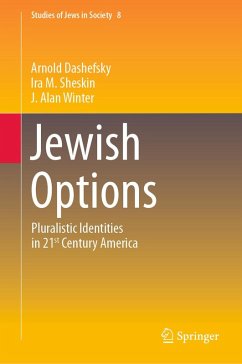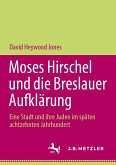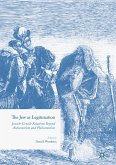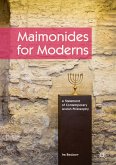Jewish Options (eBook, PDF)
Pluralistic Identities in 21st Century America


Alle Infos zum eBook verschenken

Jewish Options (eBook, PDF)
Pluralistic Identities in 21st Century America
- Format: PDF
- Merkliste
- Auf die Merkliste
- Bewerten Bewerten
- Teilen
- Produkt teilen
- Produkterinnerung
- Produkterinnerung

Hier können Sie sich einloggen

Bitte loggen Sie sich zunächst in Ihr Kundenkonto ein oder registrieren Sie sich bei bücher.de, um das eBook-Abo tolino select nutzen zu können.
This book offers an examination of an expanding set of options for being Jewish in contemporary American society. It examines the evolution of Jewish identity across five epochs of Jewish civilization as well as the transformation of the American Jewish experience across four centuries. In addition, an institutional history and a geographic, demographic, and religious profile of American Jews are presented, including an outline of contemporary Jewish options to express Jewish identity in twenty-first century America. Readers will gain an understanding of how these options developed via the…mehr
- Geräte: PC
- ohne Kopierschutz
- eBook Hilfe
- Größe: 14.72MB
![Moses Hirschel und die Breslauer Aufklärung (eBook, PDF) Moses Hirschel und die Breslauer Aufklärung (eBook, PDF)]() David Heywood JonesMoses Hirschel und die Breslauer Aufklärung (eBook, PDF)86,99 €
David Heywood JonesMoses Hirschel und die Breslauer Aufklärung (eBook, PDF)86,99 €![The Jew as Legitimation (eBook, PDF) The Jew as Legitimation (eBook, PDF)]() The Jew as Legitimation (eBook, PDF)88,95 €
The Jew as Legitimation (eBook, PDF)88,95 €![Esther in Early Modern Iberia and the Sephardic Diaspora (eBook, PDF) Esther in Early Modern Iberia and the Sephardic Diaspora (eBook, PDF)]() Emily Colbert CairnsEsther in Early Modern Iberia and the Sephardic Diaspora (eBook, PDF)72,95 €
Emily Colbert CairnsEsther in Early Modern Iberia and the Sephardic Diaspora (eBook, PDF)72,95 €![The Sephardic Atlantic (eBook, PDF) The Sephardic Atlantic (eBook, PDF)]() The Sephardic Atlantic (eBook, PDF)120,95 €
The Sephardic Atlantic (eBook, PDF)120,95 €![Zwischen Weltbürgertum und Neuem Kosmopolitismus (eBook, PDF) Zwischen Weltbürgertum und Neuem Kosmopolitismus (eBook, PDF)]() Sandra NarlochZwischen Weltbürgertum und Neuem Kosmopolitismus (eBook, PDF)59,99 €
Sandra NarlochZwischen Weltbürgertum und Neuem Kosmopolitismus (eBook, PDF)59,99 €![Maimonides for Moderns (eBook, PDF) Maimonides for Moderns (eBook, PDF)]() Ira BedzowMaimonides for Moderns (eBook, PDF)72,95 €
Ira BedzowMaimonides for Moderns (eBook, PDF)72,95 €![Jewish Integration in the German Army in the First World War (eBook, PDF) Jewish Integration in the German Army in the First World War (eBook, PDF)]() David J. FineJewish Integration in the German Army in the First World War (eBook, PDF)94,95 €
David J. FineJewish Integration in the German Army in the First World War (eBook, PDF)94,95 €-
-
-
Dieser Download kann aus rechtlichen Gründen nur mit Rechnungsadresse in A, B, BG, CY, CZ, D, DK, EW, E, FIN, F, GR, HR, H, IRL, I, LT, L, LR, M, NL, PL, P, R, S, SLO, SK ausgeliefert werden.
- Produktdetails
- Verlag: Springer Nature Switzerland
- Seitenzahl: 452
- Erscheinungstermin: 3. Oktober 2024
- Englisch
- ISBN-13: 9783031668340
- Artikelnr.: 71837756
- Verlag: Springer Nature Switzerland
- Seitenzahl: 452
- Erscheinungstermin: 3. Oktober 2024
- Englisch
- ISBN-13: 9783031668340
- Artikelnr.: 71837756
- Herstellerkennzeichnung Die Herstellerinformationen sind derzeit nicht verfügbar.
Studies and Contemporary Jewish Life at the University of Connecticut. Currently, he is Senior Academic Consultant to the Berman Jewish DataBank and Director Emeritus, as well as co-editor of the American Jewish Year Book. He has co-authored, co-edited, and edited 18 books and numerous articles and papers on Jewish identity, family, ethnicity, emigration, and interfaith marriage. He, along with Ira M. Sheskin is an author of the annual article on the American Jewish population, which appears on the Berman Jewish DataBank website and in the American Jewish Year Book. He was a founding member, secretary-treasurer, vice president, and president of the Association for the Social Scientific Study of Jewry (ASSJ) and served as editor of its journal, Contemporary Jewry. He is the recipient of the Mandel L. Berman Service Award (2012) and the Marshall Sklare Award (2020), both from ASSJ.
Ira M. Sheskin is Professor of Geography and Sustainable Development and Director of the Jewish Demography Project of the Sue and Leonard Miller Center for Contemporary Judaic Studies at the University of Miami. He is the recipient of the Marshall Sklare Award (2023) from the Association for the Scientific Study of Jewry. His main research interest is in the geography and demography of American Jews, and he is co-editor of the American Jewish Year Book. He has completed more than 50 major local Jewish community studies for Jewish Federations throughout the country and has been a consultant to numerous synagogues, Jewish day schools, Jewish agencies, Jewish nursing homes, and Jewish Community Centers throughout the country. Dr. Sheskin was a member of the National Technical Advisory Committee of the United Jewish Communities from 1988 to 2003. This committee completed both the 1990 and 2000-01 National Jewish Population Surveys. He, along with Arnold Dashefsky is an author of the annual article on the American Jewish population which appears on the Berman Jewish Data Bank website and in the American Jewish Year Book. His publications include about 60 monographs and books, including: Survey Research for Geographers; How Jewish Communities Differ; and Comparisons of Jewish Communities: A Compendium of Tables and Bar Charts. He is currently working on a book with Arnold Dashefsky called Jewish Options.
J. Alan Winter was the Lucretia L. Allen Professor of Sociology Emeritus at Connecticut College. He was honored to serve as the president of the Jewish Federation of Southeastern Connecticut. His research interests were in the sociology of religion, poverty and society, and the social scientific study of Jewry. Dr. Winter applied his expertise by serving on the advisory committee of the Center for Judaic Studies and Contemporary Jewish Life at the University of Connecticut, as well as on a variety of committees of the United Way of Southeastern Connecticut and the
Waterford Economic Development Committee. He served as editor of the journal Contemporary Jewry for ASSJ, and was the author of many articles and book chapters on a variety to topics. One of his most compelling lines of his research and publications focused on the "Cost of Living Jewishly." Among the books that he authored were Continuities in the Sociology of Religion: Creed, Congregation and Community; Clergy in Action Training (with Edgar W. Mills and Polly S. Hendrick) and Jewish Choices (with Bernard Lazerwitz, Arnold Dashefsky, and Ephraim Tabory.
The Transformation of Jewish Identity (the nature of Jewish identity over
the sweep of world history).- Chapter 2 The American Jewish Experience in
Historical and Contemporary Context (the nature of Jewish identity over the
sweep of American history).- Chapter 3 A Geographic, Demographic, and
Religious Profile of American Jews (some basic background on the geography,
demography, and religiosity of American Jews).- Chapter 4 Jewish Identity
in the American Context (an overview of the assimilation of American Jews.
Sets forth the framework for the book in terms of a liberal premise and a
social contract about what it means to be an American Jew, presents the
basic options. Table 4-1 is the theoretical framework of our argument).-
Part II: Jewish Options in the United States.- Chapter 5 Reform
Judaism: From Left to Right? (traces the history of the institutions of the
Reform movement and the opinions of its leaders, examines the opinions of
the Reform Jewish laity from 2000 to the present).- Chapter 6 Orthodox
Judaism: From Declining to Rising? (traces the history of the institutions
of the Orthodox movement and the opinions of its leaders, examines the
opinions of the Orthodox Jewish laity from 2000 to the present).- Chapter 7
Zionism: From Classical Zionism to Pro-Israelism? (traces the history of
Zionism and how Zionism among American Jews differs from the historical
philosophy. examines the opinions of the Zionist Jews from 2000 to the
present. For the first time in any research, we are able to distinguish
Zionist Jews who are secular from those who are non-secular--that is,
identify with one of the denominations in addition to their Zionism.).-
Chapter 8 Involvement in Secular Politics: From Left to Center to Right?
(examines Jews who express their identity through political involvement in
the Democratic Party (for the most part) and liberal causes (for the most
part).- Chapter 9 Conservative Judaism: From Right to Left? (traces the
history of the institutions of the Conservative movement and the opinions
of its leaders, examines the opinions of the Conservative Jewish laity from
2000 to the present).- Chapter 10 The Just Jewish: Opting Out? (examines
Jews who do not identify as Orthodox, Conservative and Reform (or other
minority denominations, but who still identify as Jewish. For the first
time in any research, we are able to distinguish Jews who call themselves
"Just Jewish" because their identity as Jews is a peripheral part of their
lives to those who call themselves Just Jewish because they simply do not
like labels or belonging to specific groups).- Part III: Twenty-first
Century Jewish Options and Challenges.- Chapter 11 American Jewry: Past,
Present, and Future Challenges to the Continuity of Community and Identity
(A summary of the book and some thoughts on the nature of Jewish identity
and the future of the American Jewish community.
The Transformation of Jewish Identity (the nature of Jewish identity over
the sweep of world history).- Chapter 2 The American Jewish Experience in
Historical and Contemporary Context (the nature of Jewish identity over the
sweep of American history).- Chapter 3 A Geographic, Demographic, and
Religious Profile of American Jews (some basic background on the geography,
demography, and religiosity of American Jews).- Chapter 4 Jewish Identity
in the American Context (an overview of the assimilation of American Jews.
Sets forth the framework for the book in terms of a liberal premise and a
social contract about what it means to be an American Jew, presents the
basic options. Table 4-1 is the theoretical framework of our argument).-
Part II: Jewish Options in the United States.- Chapter 5 Reform
Judaism: From Left to Right? (traces the history of the institutions of the
Reform movement and the opinions of its leaders, examines the opinions of
the Reform Jewish laity from 2000 to the present).- Chapter 6 Orthodox
Judaism: From Declining to Rising? (traces the history of the institutions
of the Orthodox movement and the opinions of its leaders, examines the
opinions of the Orthodox Jewish laity from 2000 to the present).- Chapter 7
Zionism: From Classical Zionism to Pro-Israelism? (traces the history of
Zionism and how Zionism among American Jews differs from the historical
philosophy. examines the opinions of the Zionist Jews from 2000 to the
present. For the first time in any research, we are able to distinguish
Zionist Jews who are secular from those who are non-secular--that is,
identify with one of the denominations in addition to their Zionism.).-
Chapter 8 Involvement in Secular Politics: From Left to Center to Right?
(examines Jews who express their identity through political involvement in
the Democratic Party (for the most part) and liberal causes (for the most
part).- Chapter 9 Conservative Judaism: From Right to Left? (traces the
history of the institutions of the Conservative movement and the opinions
of its leaders, examines the opinions of the Conservative Jewish laity from
2000 to the present).- Chapter 10 The Just Jewish: Opting Out? (examines
Jews who do not identify as Orthodox, Conservative and Reform (or other
minority denominations, but who still identify as Jewish. For the first
time in any research, we are able to distinguish Jews who call themselves
"Just Jewish" because their identity as Jews is a peripheral part of their
lives to those who call themselves Just Jewish because they simply do not
like labels or belonging to specific groups).- Part III: Twenty-first
Century Jewish Options and Challenges.- Chapter 11 American Jewry: Past,
Present, and Future Challenges to the Continuity of Community and Identity
(A summary of the book and some thoughts on the nature of Jewish identity
and the future of the American Jewish community.







